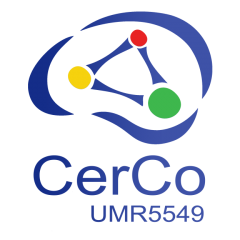The CerCo is equipped with several NeuroScan systems in practically identical configurations. The recent acquisition of several versions of the BESA (Brain Electrical Source Analysis) software enables the location of the sources at the origin of the evoked potentials obtained to be actively sought. These types of analyses have notably been used to locate the origin of the brain activity connected with cognitively complex visual processing (for faces, animals, or manufactured objects) and to approach the respective time kinetics for phonological and lexico-semantic processing, or the time kinetics of proprioceptive stimulations in patients during post-ischemic functional recovery.
EEG/ERP and ECoG in monkeys
| CerCo possesses two 32-channel Neuroscans and a 32-channel Nuamps (portable version of the neuroscan) devoted to experiments on humans. The two Neuroscans can be used together to make recordings on 64 channels. A third Neuroscan is consecrated to electrocortographic recordings in monkeys. | |
 |
|
| CerCo also has a 64-channel Biosemi system. | |
 |
|
| The main software packages used for processing EEG/ERP data are : | |
| The EEGLAB software (interactive programme for electrophysiological data processing) was developed by one of the CerCo researchers, Arnaud Delorme, in collaboration with the Swartz Center for Computational Neuroscience. For this software development, Arnaud Delorme received the ANT “Young Scientist Award”, a prize for exceptional progress in the field of EEG/MEG research. | |
Single-unit electrophysiology in monkeys
CerCo has 5 single-unit electrophysiology stations for use with non-human primates, 4 for macaques in the awake state and1 for marmosets (or macaques) with acute preparation. In the awake monkey, the activity of isolated neurones is recorded in extracellular configuration during a visual task in which stimuli are presented in their receiving field. The stimuli may be natural images or artificial stimuli, presented in 2D or 3D. Eye movements are checked by a video system (Iscan) or by the coil technique (scleral filament placed in a low-power magnetic field and giving a precision of a few minutes of arc). The possibility also exists of recording more global activity at the brain surface (near the dura mater) in the awake monkey by electrocorticography (up to 25 electrodes), which allows the evoked potentials to be measured, a frequency analysis to be performed and the synchronization to be studied from one test to another or from one electrode to another when the visual stimuli are presented. (See EEG section) In the marmoset (or macaque) in acute preparation (anaesthesia) the unit extracellular activity is recorded in response to visual stimulations comparable to those used with the awake monkey. The activity of a neurone can be recorded over a longer time (allowing a larger number of tests), and it is then possible to investigate the modulations of its activity according to the surrounding local neuronal influence. The influence of more distant cortical areas is studied by reversibly deactivating these areas using a chemical mediator (e.g. gaba) or by cooling, a technique that can also be used with awake animals.
